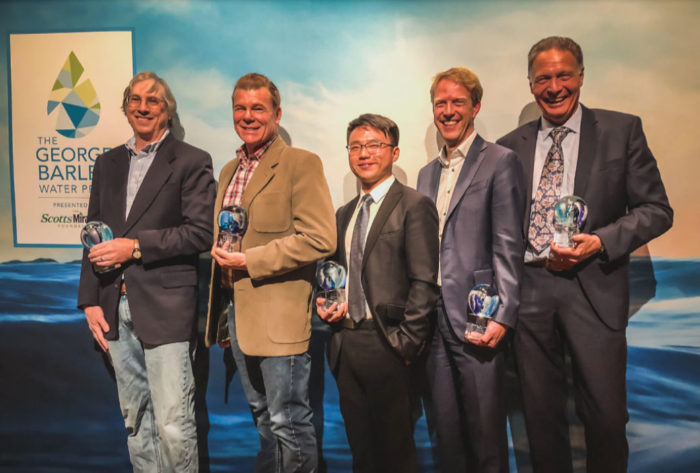Top 4 finalists prepare to head into $10 million Grand Challenge in Florida
The Scotts Miracle-Gro Foundation is the presenting sponsor for The George Barley Water Prize. The world’s largest water prize, it is a $10 million race to find a new technology capable of removing phosphorus from freshwater. Excess phosphorus is a leading cause of algal blooms that impact every state in the union and threaten our drinking and surface water supplies.
The Barley Prize is a four-stage global competition that began with more than 100 contestants representing 13 countries. Stage 3, which took place earlier this year in Ontario, Canada, challenged the top 10 remaining teams to test their technologies in real-world, cold climate conditions.
On Wednesday, October 24th, the competition reached another milestone: the announcement of the Stage 3 winners. These final four teams, from Florida, Idaho, West Virginia, and the Netherlands, will now move on to compete in the Grand Challenge, on the banks of Lake Jesup in Oviedo, Florida.

The George Barley Water Prize Final Four & First Runner-Up (Pictured left to right: Phil Sibrell – USGS, Greg Moller – University of Idaho, Yangyang Zhang – Nanjing University, Leon Korving – WETSUS, and Koos Baas – Green Water Solution, Inc.)
Winning technologies
Following is a description of the final four teams’ winning technologies:
WETSUS NAFRAD
Wetsus, a European Center of Excellence for sustainable water technologies based in Leeuwarden, the Netherlands, has developed a technology for removing phosphorus from water. It uses advanced filtration, flocculation, and high-capacity adsorption on a special granular iron-oxide material to push phosphorus down to extremely low levels. The process also produces produces calcium phosphate as a byproduct, which can be used as fertilizer.
U.S. GEOLOGICAL SURVEY – LEETOWN SCIENCE CENTER
The United States Geological Survey at Leetown Science Center in Kearneysville, West Virginia, developed a method for removing phosphorus using a byproduct from coal mining. Scientists use mine drainage ochre to develop an iron-oxide filtration bed. Besides turning a waste product from mining into a valuable resource, the method can produce a ready-to-use phosphate fertilizer.
GREENWATER SOLUTION, INC.
Green Water Solution, Inc., a private enterprise based in Wellington, Florida, has developed a proprietary technology called BioPhree(c). This is an environmentally neutral system that can remove phosphorus to 10 parts per billion even with very high inputs. The process is scalable and has been applied in industrial and municipal settings.
UNIVERSITY OF IDAHO – CLEAN WATER MACHINE
Clean Water Machine from the University of Idaho uses a filtration system that employs biochar (an activated charcoal), an iron-oxide adsorption filter, and ozone. The process removes phosphorus to extremely low levels and also produces byproducts that can be used to help food production.
What comes next
Announcement of the top four teams marks a major milestone in the Barley Prize competition. Now, each team begins working in earnest on its plans for the Grand Challenge, where they will be expected to treat up to 1 million gallons of phosphorus-rich water per day.
This competition represents our best hope for a cost-effective, widely adopted solution to the problem of phosphorus-fed algal blooms which now affect 15,000 water bodies nationwide. By advancing to the final Grand Challenge round, the remaining teams have demonstrated they have what it takes to help secure safe water, both now and in the future.


